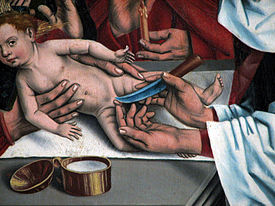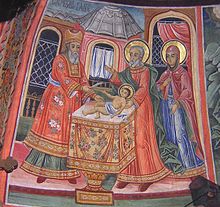- Holy Prepuce
-
 Circumcision of Christ (detail), by Friedrich Herlin
Circumcision of Christ (detail), by Friedrich Herlin
The Holy Prepuce, or Holy Foreskin (Latin præputium or prepucium) is one of several relics attributed to Jesus, a product of the circumcision of Jesus.
At various points in history, a number of churches in Europe have claimed to possess Jesus' foreskin, sometimes at the same time. Various miraculous powers have been ascribed to it.
Contents
History and rival claims
All Jewish boys are required by Jewish religious law to be circumcised on the eighth day following their birth; the Feast of the Circumcision of Christ, still celebrated by many churches around the world, accordingly falls on January 1. Luke 2:21 (King James Version), reads: "And when eight days were accomplished for the circumcising of the child, his name was called JESUS, which was so named of the angel before he was conceived in the womb."[1] The first reference to the survival of Christ's severed foreskin comes in the second chapter of the apocryphal Arabic Infancy Gospel which contains the following story:
- And when the time of his circumcision was come, namely, the eighth day, on which the law commanded the child to be circumcised, they circumcised him in a cave.
- And the old Hebrew woman took the foreskin (others say she took the navel-string), and preserved it in an alabaster-box of old oil of spikenard.
- And she had a son who was a druggist, to whom she said, "Take heed thou sell not this alabaster box of spikenard-ointment, although thou shouldst be offered three hundred pence for it."
- Now this is that alabaster-box which Mary the sinner procured, and poured forth the ointment out of it upon the head and feet of our Lord Jesus Christ, and wiped it off with the hairs of her head.[2]
Foreskin relics began appearing in Europe during the Middle Ages. The earliest recorded sighting came on December 25, 800, when Charlemagne gave it to Pope Leo III when the latter crowned the former Emperor. Charlemagne claimed that it had been brought to him by an angel while he prayed at the Holy Sepulchre, although a more prosaic report says it was a wedding gift from the Byzantine Empress Irene. The Pope placed it into the Sanctum sanctorum in the Lateran basilica in Rome with other relics.[3] Its authenticity was later considered to be confirmed by a vision of Saint Bridget of Sweden.[4] The foreskin was then looted during the Sack of Rome in 1527. The German soldier who stole it was captured in the village of Calcata, 47 km north of Rome, later the same year. Thrown into prison, he hid the jeweled reliquary in his cell, where it remained until its rediscovery in 1557. Many miracles (freak storms and perfumed fog overwhelming the village) are claimed to have followed.[5] Housed in Calcata, it was venerated from that time onwards, with the Church approving the authenticity by offering a ten-year indulgence to pilgrims.[3] Pilgrims, nuns and monks flocked to the church. "Calcata was a must-see destination on the pilgrimage map." The foreskin was reported stolen by a local priest in 1983.[5]
According to the author David Farley, "Depending on what you read, there were eight, twelve, fourteen, or even 18 different holy foreskins in various European towns during the Middle Ages."[6] In addition to the Holy Foreskin of Rome (later Calcata), other claimants included the Cathedral of Le Puy-en-Velay, Santiago de Compostela, the city of Antwerp, Coulombs in the diocese of Chartres, France as well as Chartres itself, and churches in Besançon, Newport[citation needed], Metz, Hildesheim, Charroux, Conques, Langres, Fécamp, Stoke-on-Trent[citation needed], Calcata, and two in Auvergne.[6]
One of the most famous prepuces arrived in Antwerp in the Brabant in 1100 as a gift from king Baldwin I of Jerusalem, who purchased it in Palestine in the course of the first crusade. This prepuce became famous when the bishop of Cambray, during the celebration of the Mass, saw three drops of blood blotting the linens of the altar. A special chapel was constructed and processions organised in honour of the miraculous relic, which became the goal of pilgrimages. In 1426 a brotherhood was founded in the cathedral "van der heiliger Besnidenissen ons liefs Heeren Jhesu Cristi in onser liever Vrouwen Kercke t' Antwerpen"; its 24 members were all abbots and prominent laymen. The relic disappeared in 1566, but the chapel still exists, decorated by two stained glass windows donated by king Henry VII of England and his wife Elizabeth of York in 1503.
The abbey of Charroux claimed the Holy Foreskin was presented to the monks by Charlemagne. In the early 12th century, it was taken in procession to Rome where it was presented before Pope Innocent III, who was asked to rule on its authenticity. The Pope declined the opportunity. At some point, however, the relic went missing, and remained lost until 1856 when a workman repairing the abbey claimed to have found a reliquary hidden inside a wall, containing the missing foreskin. The rediscovery, however, led to a theological clash with the established Holy Prepuce of Calcata, which had been officially venerated by the Church for hundreds of years; in 1900, the Roman Catholic Church resolved the dilemma by ruling that anyone thenceforward writing or speaking of the Holy Prepuce would be excommunicated.[5] In 1954, after much debate, the punishment was changed to the harsher degree of excommunication, vitandi (shunned);[5] and the Second Vatican Council later removed the Day of the Holy Circumcision from the Latin church calendar, although Eastern Catholics and Traditional Roman Catholics still celebrate the Feast of the Circumcision of Our Lord on January 1.[5][7]
Modern practices
Most of the Holy Prepuces were lost or destroyed during the Reformation and the French Revolution.[5]
The Holy Prepuce of Calcata is worthy of special mention, as the reliquary containing the Holy Foreskin was paraded through the streets of this Italian village as recently as 1983 on the Feast of the Circumcision, which was formerly marked by the Roman Catholic Church around the world on January 1 each year. The practice ended, however, when thieves stole the jewel-encrusted case, contents and all.[5] Following this theft, it is unclear whether any of the purported Holy Prepuces still exist. In a 1997 television documentary for Channel 4, British journalist Miles Kington travelled to Italy in search of the Holy Foreskin, but was unable to find any remaining example.
Historical allusions and references to the Holy Prepuce
Voltaire, in A Treatise of Toleration (1763), ironically referred to veneration of the Holy Foreskin as being one of a number of superstitions that were "much more reasonable... than to detest and persecute your brother". [8]
Umberto Eco, in his book Baudolino, has the young Baudolino invent a story about seeing the holy foreskin and navel in Rome to the company of Frederick Barbarossa.
In July 2009, Penguin/Gotham Books published An Irreverent Curiosity: In Search of the Church's Strangest Relic in Italy's Oddest Town, American writer David Farley's account of trying to locate the Holy Foreskin of Calcata.
In Chuck Palahniuk's book Choke, the main character is told that he was cloned from Jesus' foreskin.
See also
- Circumcision
- Circumcision controversy in early Christianity
- Holy Umbilical Cord
- Shroud of Turin
- True Cross
References
- ^ http://www.biblegateway.com/passage/?version=9&search=Luke+2:21
- ^ The Lost Books of the Bible, New York: Bell Publishing Company, 1979
- ^ a b "Who stole Jesus' foreskin?" by David Farley. Slate magazine
- ^ Leonard B. Glick, Marked in Your Flesh: Circumcision From Ancient Judea to Modern America, OUP, 2005, p. 96
- ^ a b c d e f g "Fore Shame", David Farley, Slate.com, Tuesday, Dec. 19, 2006
- ^ a b Who stole Jesus' foreskin? by David Farley. Slate magazine
- ^ See the General Roman Calendar as in 1954, the General Roman Calendar of Pope Pius XII, and the General Roman Calendar of 1962
- ^ Voltaire: A Treatise on Tolerance
- Müller, Alphons Victor: Die hochheilige Vorhaut Christi im Kult und in der Theologie der Papstkirche, Berlin 1907.
- Shell, Marc: "The Holy Foreskin; or, Money, Relics, and Judeo-Christianity." Jews and Other Differences: The New Jewish Cultural Studies. Ed. Jonathan Boyarin and Daniel Boyarin. Minneapolis: U of Minnesota P, 1997.
- Palazzo, Robert P, "The veneration of the sacred foreskin(s) of baby Jesus : a documented analysis," Multicultural Europe and cultural exchange in the Middle Ages and Renaissance, ed. James P. Helfers. Turnhout, Belgium: Brepols, 2005.
External links
- Relics article from the Catholic Encyclopedia
- The Relics of Romanism article at the European Institute of Protestant Studies (anti-Catholic site)
- Peter Charles Remondino. History of Circumcision from the Earliest Times to the Present. Philadelphia and London; F. A. Davis; 1891.
- "Searching for Christianity's Most Sensitive Remnant" in Toronto Star
Categories:- Circumcision
- Relics associated with Jesus
- Body parts of individual people
- Jesus and history
Wikimedia Foundation. 2010.

